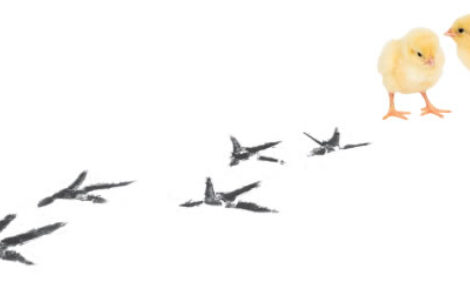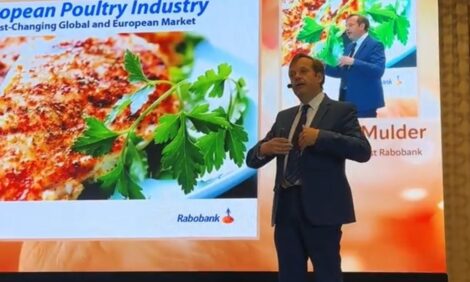



Heat Stress in poultry - Solving the problem
By Defra - This article is intended to describe the main causes of heat stress in poultry and to outline some of the common sense management measures that will help to prevent it.1. Introduction
Current production methods often involve large numbers of birds being housed together making them susceptible to heat stress. Heat Stress not only causes suffering and death in the birds, but results in reduced or lost production and hence adversely affects the profit from the enterprise.
This booklet discusses some of the key principles involved in reducing heat stress. Whilst it embodies much of the latest advice and the best current husbandry practices, it cannot be exhaustive and is not intended as a substitute for expert advice. If in doubt about a problem, expert advice should be sought.
2. What is heat stress?
Body Heat Balance
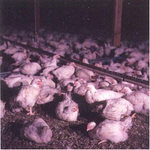 Heat is produced by essential bodily processes (metabolism) which include maintenance, growth and egg production. Heat production is affected by body weight, species and breed, level of production, level of feed intake, feed quality and, to a lesser extent, by the amount of activity and exercise.
Heat is produced by essential bodily processes (metabolism) which include maintenance, growth and egg production. Heat production is affected by body weight, species and breed, level of production, level of feed intake, feed quality and, to a lesser extent, by the amount of activity and exercise.
If the stocking density is too high for the size and design of house and ventilation equipment, the temperature may rise dangerously since there will be more metabolic heat being added to the house air than was planned for. Radiant transfer from bird to bird is then greater and stagnant hot air is trapped between the birds.
Although temperature measured with an ordinary thermometer is the simplest single index of thermal strain on birds, there is much more to it than that. Characteristics of the bird which affect heat loss include feather cover and the size of the combs and wattles. Posture has considerable influence on heat loss.
Heat can be lost in a variety of ways:
- Radiation - losses are proportional to the temperature difference between the body surface and the surrounding surfaces. Thus, hot poorly insulated roofs increase house temperature and make heat stress worse in hot weather as does direct sun on free range birds.
- Convection - heat loss will occur from the natural rise of warm air from around a hot body. It can be assisted by providing moving air but only if the air moves fast enough to break down the boundary layer of still air which surrounds the body.
- Evaporation - such losses are very important at high temperatures. Poultry do not sweat, but they depend on panting, and this is only effective if the humidity is not too high. Hot humid conditions are therefore much more stressful than hot dry conditions.
- Conduction - conduction is relatively unimportant but heat will flow by direct surface to surface transfer if the birds are seated on litter which is cooler than their bodies. However, the litter immediately under the birds soon assumes a temperature close to that of the body.
Heat is added to the air of a building by the body heat production, heat from electric lights and motors, sometimes heat from the roof and walls, and heat from fermentation of the litter or accumulated droppings. Of these, the dominant source of heat is body heat. Fermentation of litter is usually at least equalled by the heat absorbed in evaporating litter moisture. The heat of electric lights and motors is a very small fraction of that produced by the body metabolism (normally less than 1%). However, radiated heat coming from a poorly insulated roof can make heat stress worse in hot weather.
Heat is lost via ventilated air and by conduction through the roof and walls when not in direct sunlight. In hot weather, the air change is the dominant route.
The body temperature of a bird must remain within narrow limits if its welfare is to be safeguarded and production maintained at acceptable levels. Therefore, there has to be a balance between body heat production and body heat loss. Heat is lost, at a controlled rate, so that body temperature is held constant. The birds are stressed if they have difficulty achieving this balance and die when heat production is substantially greater than heat loss over long periods.
The main indicator of heat stress is prolonged panting. If this is not rectified, it will lead to collapse and death of the birds.
3. Prevention of heat stress
Buildings - Reducing Radiant Heat Gain
Even in a British summer it is surprising how much solar heat can penetrate a roof if the insulation is deficient. Recent measurements have shown solar gains of up to 30 Watts per square metre (W/m2 ) coming through old broiler house roofs, and as much as 85 W/m2 through single skin roofs. It is important to check the standard of your insulation and to bring it up to the modern recommended standard U value* of 0.4 W/m2 / °C or better, as soon as possible. This will also give winter benefits to both welfare and production, due to reduced brooding cost and better air quality at a given temperature by permitting higher ventilation rates. Roof colour, reflectivity, pitch and orientation, and whether the building is in the shade or not are also factors which will have a small bearing on solar heat gain and expert advice should be sought at the design stage.
*U Value is the heat in Watts which passes through each square metre for every 1°C difference between inside and outside temperature.
The choice of insulation material depends upon the type of building structure but, whether material is chosen, it is important to provide a vapour check layer between the insulant and the internal air. Deficiencies in this cheap but important detail have often been the cause of premature deterioration of expensive insulation materials. Some of the modern rigid sheet insulants are supplied with a vapour check layer, or are inherently vapour impervious. This should be checked with the supplier. It is most important that the joints between the sheets are sealed after fitting.
Ventilation and Air Distribution
Standard British maximum ventilation rate recommendations from ADAS and other sources are based on physical calculations of the quantity of air needed to prevent the bird heat raising house temperature by more than 3°C above outside temperature. Even when there is enough air in the house it is necessary to distribute it uniformly to all of the birds. Modern ventilation systems are designed to achieve this, but unfortunately there are still many inherently poor systems in use.
In naturally ventilated houses, the required rate of air change dictates the size of the openings in the walls and roof, and these are calculated according to the height of the building. Thus there is no single rule of thumb for natural ventilation and calculations for each house must be carried out individually. Such calculations may require the services of ADAS or other ventilation consultants.
In power ventilated houses, the maximum ventilation rate recommended dictate the size and number of fans, and have led to simple rules of thumb, such as 1 x 620mm 900 rpm fan per 1,000 laying hens. This rule of thumb can also be applied to broilers.
Circulation fans
It is important to distinguish between internal circulation fans, which do not change the air, and the main ventilation fans which do.
In hot weather it is often essential to increase the rate of convection loss from the birds by increasing air speed at bird level with extra fans. This technique is particularly useful for broilers on the floor. Recent research suggests an allocation of about 1 circulation fan every 10 to 15 metres along the house, mounted about 2 metres off the floor and aimed slightly downwards. Circulation fans give additional benefits such as getting broilers to stand up and breaking up the layer of stagnant hot air which tends to form around the birds.
Slow turning ceiling fans were used in early attempts to achieve adequate air mixing but are not now recommended. It is better to use ordinary propeller fans, mounted for horizontal delivery because they are more effective in increasing the air speed at bird level in hot weather.
Problems with ventilation equipment
To avoid serious welfare problems during breakdowns it is essential that ventilation equipment is properly installed and regularly maintained and that alternative ventilation is available in the event of an emergency.
Unfortunately there are many installation where the fan performance has been impaired by simple installation errors. For example, the fan box is too small for its fan or the fan box obstructs the air flow in some way. Another common fault is that no bellmouth or diaphragm has been fitted on the fan mounting, or an incorrect mounting ring has been fitted.
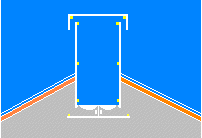 Poor design - internal obstructions, square cap and turbulent airflow |
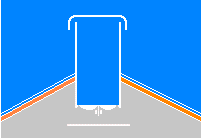 Good design - rounded cap and streamlined flow |
All these errors are easily, and often cheaply avoided, by mounting fans according to the manufacturers instructions but expert advice should be sought if necessary. Complete installation packages should be used to obtain the best performance of the ventilation system.
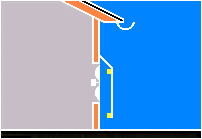 Poor design - obstructed interior, too near ground and too narrow |
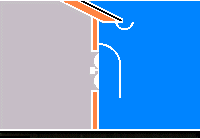 Good design - rounded, smooth interior, ground clearance and correct fan width |
Evaporative devices
There are now devices available for evaporative cooling. However, they should only be used when the house air is hot and dry not during hot humid weather. It could be dangerous to use evaporative cooling when the relative humidity exceeds about 70%, as the efficiency of the birds' heat loss through panting may be impaired.
Stocking density
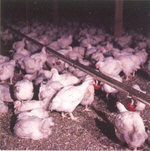 Where possible, and in particular in older broiler houses with less efficient ventilation equipment, it is sound practice to reduce stocking densities in the summer.
Where possible, and in particular in older broiler houses with less efficient ventilation equipment, it is sound practice to reduce stocking densities in the summer.
The frequency of occurrence of warm spells of weather varies systematically across the country. For example, coastal areas will generally experience fewer very hot spells than inland areas. For further information on such predictions, contact the Meteorological Unit at ADAS Wolverhampton (01902 754190) or other meteorological services. It is possible to calculate the maximum stocking density that any particular poultry house can support in hot weather using known facts about the house and its ventilation efficiency. ADAS or other consultants can undertake such calculations which will include all of the aspects that will affect flock size such as species and breed, level of feed intake and quality, slaughter age, anticipated live-weight and whether flocks are sexed or "as hatched".
At no time should the stocking densities exceed those recommended in the relevant Welfare Codes.
Predictions of hot weather over the week ahead for any location can also be arranged through the Meteorological Unit or other meteorological services. Should there be a risk at any time of air temperature rising to dangerous levels for the birds despite careful planning, the stocking density should be reduced, for example by thinning the broiler crop.
4. Depopulation and transport
At times of high ambient temperature or when high humidity poses a threat to the birds, catching, loading and transportation create particular risks of heat stress. It is important that plans are made in advance to reduce the risk. Such plans should include the daily receipt of meteorological forecasts of predicted temperatures for the next few days so that appropriate action can be taken.
All parts of poultry operations should have detailed instructions and lines of communications established so that the correct action can be taken when triggered by either high temperature or humidity. If catching and transport is contracted out, close liaison must be maintained with the contractors and a representative of both the farm and the contractor should always be present or available to take any decisions necessary to safeguard the welfare of the birds.
Whatever method is used for catching birds, it is essential that the process takes the minimum time possible which is consistent with ensuring bird welfare. Where possible, catching and loading should be timed for the coolest part of the day. Staff and equipment should be well prepared beforehand and a team leader with overall responsibility should be appointed to co-ordinate the operation. Ventilation must be provided for uncaught birds until the time they are loaded and, if necessary, additional mobile fans must be provided during the catching operation. Where appropriate in large buildings, shed doors should be closed while crates are loaded onto the vehicle. Water should be given regularly to the uncaught birds by periodically lowering the drinkers, ensuring that sufficient light is available for the purpose.
Stocking densities in the crates should be adjusted according to the temperature and crate design. Once birds are crated, neither the crates nor the vehicle should be left in direct sunlight. Crates should be stacked on the vehicle so as to allow sufficient ventilation, for example, by leaving the top row of crates empty when the load is covered. Ventilation holes should be opened on fixed crate vehicles. If a delay in loading occurs, ventilation must be provided for the birds either by unloading the crates into a cool and well ventilated place (for example, back in the shed) or by driving the vehicle around. A fully loaded vehicle should never be allowed to stand for any length of time on site at the farm or at the slaughterhouse unless in a suitably and efficiently ventilated lairage.
5. Adequate provision for ventilation failure
 Alarms to warn of failure of the ventilation system are not only sensible and common features of modern ventilation systems but they are also mandatory when the birds' welfare depends on powered ventilation. The Welfare of Livestock Regulations 1994 requires an alarm which will give adequate warning of the failure of the system to function properly and additional equipment which will provide adequate ventilation so as to protect the birds from suffering unnecessary pain or unnecessary distress. A principal consequence of failure of the primary ventilation system is temperature rise with risk of heat stress and death. Therefore, emergency equipment is designed to prevent excessive temperature rise.
Alarms to warn of failure of the ventilation system are not only sensible and common features of modern ventilation systems but they are also mandatory when the birds' welfare depends on powered ventilation. The Welfare of Livestock Regulations 1994 requires an alarm which will give adequate warning of the failure of the system to function properly and additional equipment which will provide adequate ventilation so as to protect the birds from suffering unnecessary pain or unnecessary distress. A principal consequence of failure of the primary ventilation system is temperature rise with risk of heat stress and death. Therefore, emergency equipment is designed to prevent excessive temperature rise.
The detailed design of the emergency equipment is beyond the scope of this booklet, but designs and required capacities are readily available from ADAS and other poultry consultants. The equipment is normally designed to prevent house temperatures from rising more than 5°C above the outside temperature. Typical devices include generators and fail-safe panels.
6. Staff training
Contingency plans
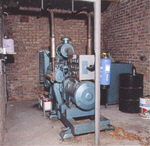 Poultry producers should ensure that all staff are able to recognise the early signs of heat stress and that senior stockmen and certain other staff are familiar with the ventilation systems built into the poultry house. Plans should be made in advance to deal with hot weather emergencies. Such plans should include action to be taken and by whom both during normal operations and while the birds are depopulated and transported.
Poultry producers should ensure that all staff are able to recognise the early signs of heat stress and that senior stockmen and certain other staff are familiar with the ventilation systems built into the poultry house. Plans should be made in advance to deal with hot weather emergencies. Such plans should include action to be taken and by whom both during normal operations and while the birds are depopulated and transported.
Contingency plans should cover either a partial or complete breakdown of equipment (such as back up systems failing) and designate different roles to members of staff as necessary. Emergency instructions should be clearly displayed for all staff and these should include telephone numbers of veterinary surgeons and equipment engineers. A person should be available or on-call at all times who has authority to take whatever decisions are necessary to protect the welfare of the birds.
To avoid Heat Stress
- Provide adequate ventilation for the number of birds housed.
- Do not exceed recommended Welfare stocking densities.
- Where possible, reduce stocking densities during hot weather both in the shed and during transport.
- Regularly maintain and test alarms and emergency ventilation equipment.
- Insulate the house structure sufficiently to avoid solar heat gain.
- Position sufficient circulation fans correctly.
- Make contingency plans in advance so all know their respective roles and ensure that someone is available with authority to take decisions.
Source: Defra - July 2003







